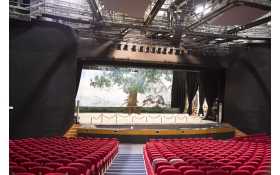Mina stays hidden at Ko Shan Theatre
Published: ASIA

HONG KONG: A Meyer Sound Mina system is the centrepiece of a recent upgrade at the Ko Shan Theatre in Hong Kong. The venue, which can accommodate up to 1,300 seated guests and mainly supports Cantonese opera productions, chose the low-profile Meyer Sound system as it was important that the PA ‘had zero visibility’. The installation was carried out by the manufacturer’s Hong Kong dealer, Audio Dynamic.
‘The Mina system has been more than just a technology upgrade – it has truly transformed our entire audio operation and system workflow,’ enthused Yeung Tsz Yung, the theatre’s resident deputy technical manager. ‘We are very impressed and truly appreciate the support Meyer Sound provided before, during and after the installation.’
Replacing the previous system of CQ Series speakers, an LCR configuration comprises hidden left and right arrays of six Mina each, a centre array of eight M1D line array modules and two 700-HP subwoofers concealed in the ceiling rigging. Six MM-4XP self-powered loudspeakers provide front-fill and three UPA-1P loudspeakers cover the balcony. A Galileo Callisto loudspeaker management system with two Galileo Callisto 616 array processors provides drive and alignment.
‘The Mina arrays are hung within cave-like concrete compartments, and concealed behind black mesh cloth – the same fabric that Meyer Sound uses on its cinema surround loudspeakers,’ continued Brian Chow of Audio Dynamic. ‘The compartments are small, narrow and an odd, asymmetrical shape. The arrays are small enough to fit and yet they still provide enough power to compete with the exceptionally loud Cantonese opera percussion.’
The theatre originally opened in 1983 as a 3,000-seat, semi-open-air venue. After several years of struggling with weather and noise issues, it was completely redesigned as an indoor venue. ‘With the building’s new construction, we were left with very little space, and very tight spaces to run conduit for speaker cables,’ added Mr Chow. ‘Because Mina is self-powered, it enabled us to save space and not have to worry about an amplifier rack and cabling.’
